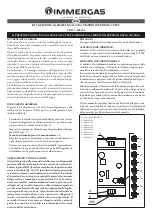
32
WARNING
Improper adjustments to control parameters could result in unreliable boiler
operation, property damage, personal injury, or loss of life. Adjustments should
only be made by a qualified heating technician.
A list of parameters which can be changed on this control are shown in Table 11.5. To enter Adjustment mode and change
parameters:
1) Press and hold
I,
↑
,
↓
together for at least 3 seconds.
2) Use
I
to advance to the parameter which is to be changed.
3) Use the
↑
or
↓
buttons to change the setting or select from possible choices. See below for additional information on
the use of these parameters.
4) If other parameters are to be changed, use the
I
button to advance to the next parameter needing adjustment and change it
in the same way.
5) After all parameters have been changed, use the
I
button to advance until
bAc
is shown on the display.
6) Press either the
↑
or
↓
key to return to Status mode. Alternatively, the control will return to Status mode if no key is
touched for 5 minutes.
HL
(High limit Set point) - Burners shut down if the boiler water temperature exceeds this setting. The circulator will continue
to run. Unless the Crown outdoor reset card is installed, the high limit setting also serves as the water temperature set point (
SP
)
during calls for both heat and DHW.
dF
(High limit differential) - If the boiler shuts off on high limit, the water temperature must fall by an amount equal to the
differential during the same call for heat before the burners will again start. For example, with HL=180 and dF=15, the burners
will shut off if the water temperature exceeds 180F and stay off until the temperature falls to 165F (180 - 15). Note that if all calls
for heat end while the burners are off on high limit, the burner will not restart during the next call for heat until the thermal purge
requirements described below are met.
Or
(Circulator Overrun) - Determines how long the Heating Circulator will operate after the call for heat ends. In some cases, this
can help reduce energy consumption by sending heat stored in the boiler out into the system. At the same time, caution should
be exercised before setting this value to something other than zero. Before doing so, verify that the system will permit flow (e.g.
flow is not completely cut-off by closed zone valves) and that the overrun will not cause overheating problems.
Circulator overrun is only possible on the heating zone. The DHW Circulator will not over-run, even if the DHW zone is used
as a second heating zone.
PP
(Thermal Purge Time) - Upon a call for heat, the boiler will prevent burner operation until either:
•
The water temperature drops below the Thermal Purge start temperature (
St
) OR:
•
The thermal purge time has passed
For some examples of this operation, see Table 11.6. If the “DHW” zone is used for space heating (dh=tt2), this thermal purge
function will also keep the burner off at the beginning of a call from the thermostat connected to the “DHW” terminals in the
manner described above. If the “DHW” zone is being used for DHW (dh=dh), the burners will immediately come on upon a call
for DHW as long as the water temperature is below the high limit setting.
Thermal purge is only invoked when a call for heat first appears and the boiler is not already firing. For this reason, if the boiler
is already firing in response to an call for heat, and a call for heat appears at the second zone, the boiler will continue to fire.
St
(Thermal Purge Start Temperature) - See description for Thermal Purge Time above.
C. Using Adjustment Mode
Содержание AWR Series
Страница 2: ......
Страница 19: ...17 FIGURE 8 5 BOILER BYPASS PIPING FIGURE 8 6 ISOLATION OF BOILER FROM SYSTEM WITH A HEAT EXCHANGER...
Страница 23: ...21 FIGURE 9 0 LINE VOLTAGE FIELD CONNECTIONS FIGURE 9 1 LOW VOLTAGE FIELD CONNECTIONS...
Страница 24: ...22 FIGURE 9 2 INTERNAL CONNECTIONS DIAGRAM...
Страница 25: ...23 FIGURE 9 3 LADDER DIAGRAM...
Страница 43: ...41 Notes...
Страница 45: ...43...
Страница 47: ...45...
















































